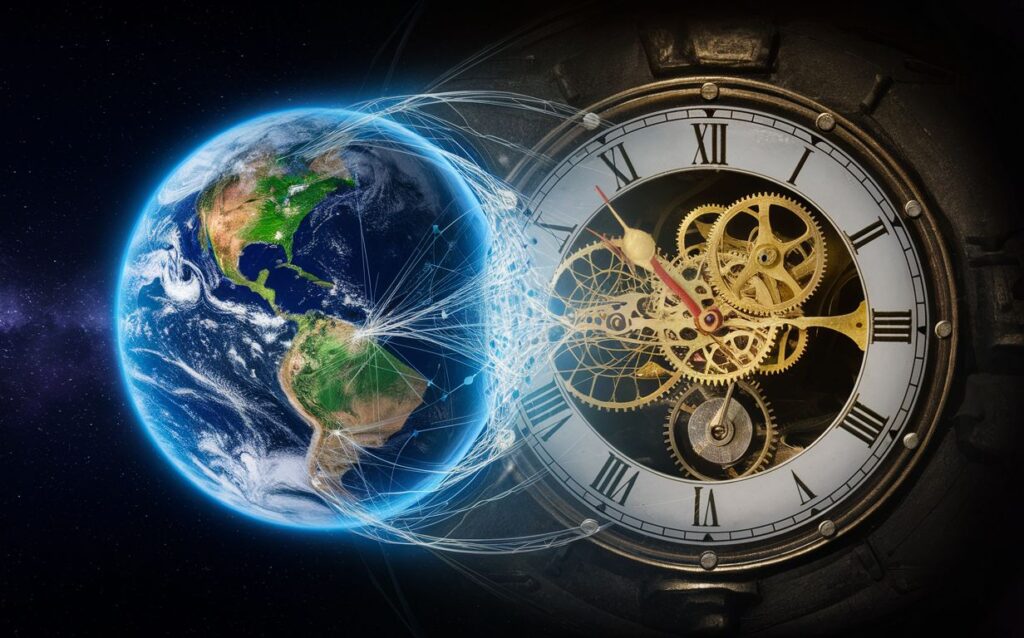
Physicists are challenging long-held beliefs about the nature of time, suggesting it may be an illusion born from quantum entanglement. This groundbreaking study, published in Physical Review A, proposes that time emerges from the interactions of quantum systems, rather than existing as an independent entity.
The research revisits the Page and Wootters (PaW) mechanism, a theory from 1983 that treats time as a quantum observable. This approach contrasts with the traditional view of time as a fixed dimension, offering a fresh perspective on a fundamental aspect of our universe.
Physics and Time
The concept of time has long puzzled physicists, particularly due to its inconsistent treatment in major theories. In quantum mechanics, time is an external parameter, used to measure changes but not existing within the system itself. This creates a paradox: how can time govern change if it doesn’t exist inside the quantum system?
Conversely, Einstein’s general relativity describes time as flexible, influenced by speed and gravity. For instance, time slows near a black hole, indicating its fluid nature. This disparity between quantum mechanics and relativity is known as the “problem of time.”
“It seems there is a serious inconsistency in quantum theory. This is what we call the problem of time.” — Alessandro Coppo, National Research Council of Italy
Such inconsistencies hinder the development of a unified theory that encompasses both quantum mechanics and general relativity.
Quantum Time Emergence Framework
The PaW mechanism offers a novel solution by suggesting that time arises from entanglement between quantum systems. In this framework, one system acts as a clock, while the other is measured. Without this interaction, time ceases to exist, leaving the universe as a static snapshot.
Researchers tested this theory using a model of two entangled quantum systems: a vibrating harmonic oscillator representing the world and a group of magnetic spins acting as the clock. The oscillator’s change over time, driven by its entanglement with the clock, aligns with the predictions of the Schrödinger equation.
This perspective suggests that time is a product of quantum relationships, not a separate entity we move through.
Bridging the Quantum-Classical Divide
The study extends the PaW mechanism to macroscopic systems, showing that classical physics emerges from quantum mechanics. By treating either the clock or the oscillator as a classical object, the equations simplify to those used in classical physics.
“We strongly believe that the correct and logical direction is to start from quantum physics and understand how to reach classical physics, not the other way around.” — Alessandro Coppo
This finding implies that classical time is a byproduct of quantum entanglement, challenging the notion of time as a fundamental aspect of reality.
Implications and Future Challenges
While the theory is mathematically consistent, it lacks experimental validation. Some physicists remain skeptical, questioning whether the PaW mechanism can lead to practical modifications in quantum physics and general relativity.
“Yes, it is mathematically consistent to think of universal time as the entanglement between quantum fields and quantum states of 3D space. However, no one knows if anything new or fruitful will come out of this picture.” — Vlatko Vedral, University of Oxford
Experimental evidence is crucial to confirm whether time truly emerges from entanglement. Future experiments must measure these effects in real-world systems to validate the theory.
Despite uncertainties, some researchers see this as a step toward understanding time. Adam Frank, a theoretical physicist at the University of Rochester, suggests that time might only make sense from within a system, not as an external phenomenon.
“Maybe the only way to understand time is not from some God’s-eye perspective, but from the inside, from a perspective of asking what is it about life that manifests such an appearance of the world.” — Adam Frank
If time as an emergent property is proven, it could revolutionize our understanding of quantum gravity and reality itself. However, until experiments provide clarity, time remains one of physics’ greatest mysteries.
More About the Page and Wootters (PaW) Mechanism
Proposed by Don Page and William Wootters in 1983, the PaW mechanism addresses the “problem of time” by suggesting that time emerges from quantum entanglement. Traditionally, quantum mechanics treats time as an external parameter, while general relativity views it as a dynamic entity within spacetime.
In the PaW framework, the universe is described by a timeless quantum state. Time arises through correlations between subsystems, with one acting as a quantum clock. This relational view aligns with relativity’s observer-dependent time and quantum entanglement theory.
Despite its theoretical appeal, PaW faces challenges in defining universal quantum clocks and describing classical time in realistic scenarios. Advances in quantum information theory and experimental proposals continue to explore PaW’s potential, highlighting its role in understanding the interplay between quantum mechanics, entanglement, and time.




